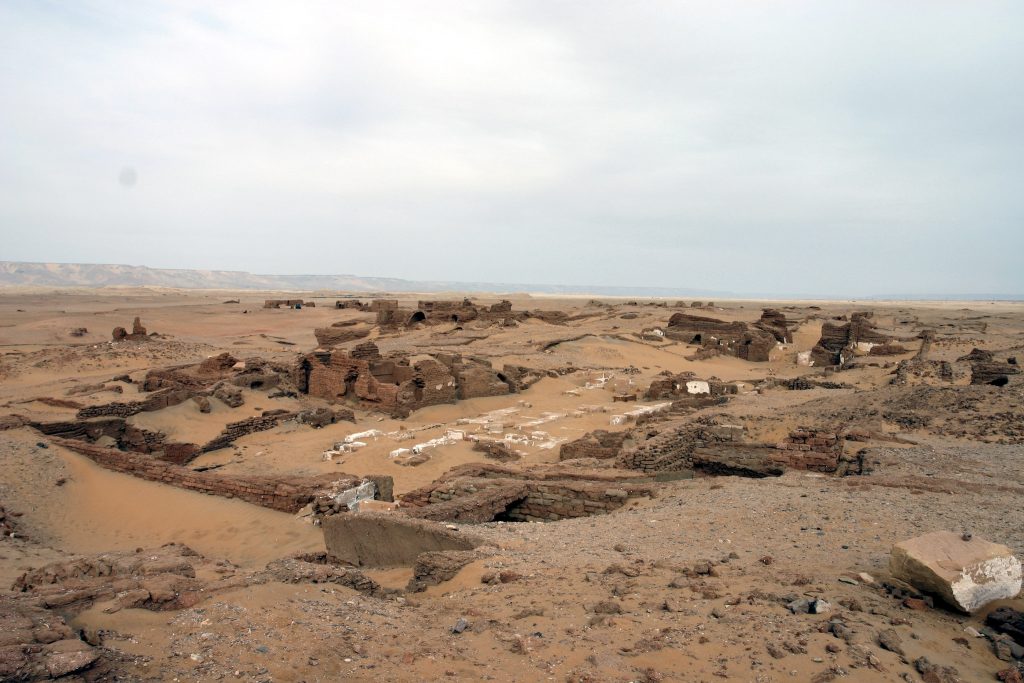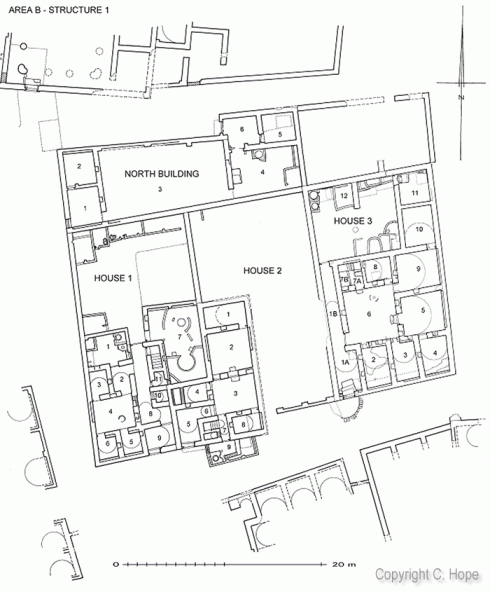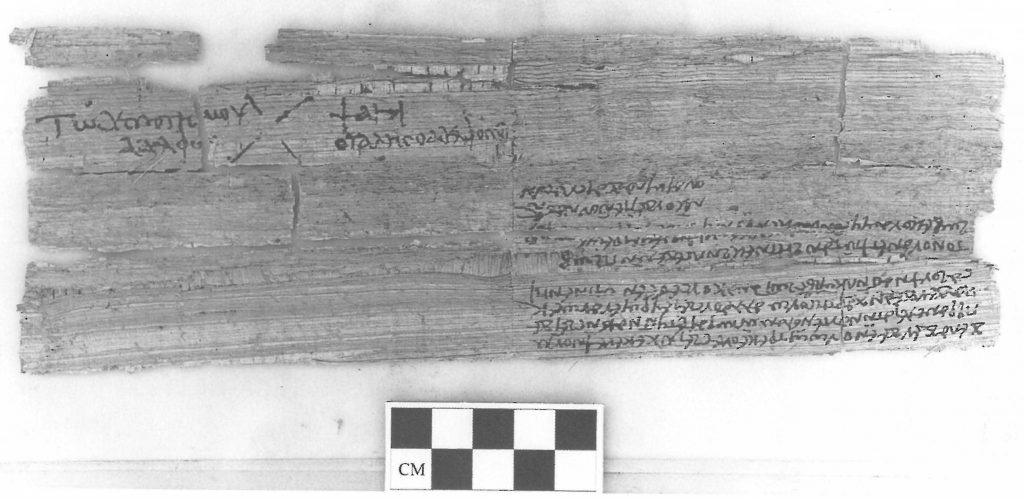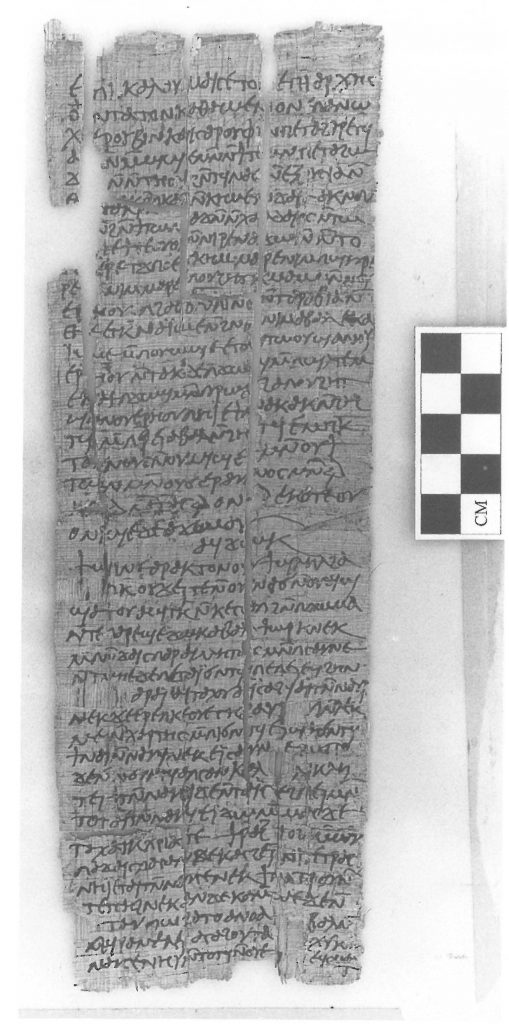
This week we’re going to take another look at one of the most unusual magical texts to survive from Late Antique Egypt, P. Kell. Copt. 35, a letter containing a magical spell intended to separate a couple. We already discussed this text briefly in our post about Manichaeism and magic – like all of the texts from the ancient oasis-city of Kellis, this papyrus was uncovered by the excavations of the team from the University of Monash in Melbourne, Australia, led by Colin Hope. It was found in House 3 of Area A, inhabited in the fourth century by several generations of an extended family of Manicheans, who abandoned it suddenly in the last decade of that century, perhaps because soil depletion and the encroachment of the desert was making agriculture impossible and covering their house in sand.

After the abandonment of the site, P. Kell. Copt. 35 broke into four pieces, which were recovered from room 6, a large, central space which is on the right on entering the house. It was found among debris including the palm ribs which would have once covered the roof, perhaps indicating that, like many of the other texts, it was once stored in a jar which fell and broke as the walls and roof collapsed. It was first translated by Anthony Alcock, who later published it together with Paul Mirecki and Iain Gardner, before being re-published with other Coptic texts from Kellis in the volume Coptic Documentary Texts from Kellis, by Gardner, Alcock and Wolf-Peter Funk in 1999.

Like all papyrus letters in antiquity, it would have been folded to hide its contents, and given to a friend or acquaintance who was visiting the recipient. On the back, which would have been visible, is the address, written in Greek:
To my lord brother, Psais × from Ouales, his brother.
P. Kell. Copt. 35 verso ll.1-2
Psais is the Greek form of the Egyptian name Pshai, which survives among modern Copts as Bishoy. We know that this Pshai was one of the inhabitants of House 3, probably one of the members of the last generation who lived there from about 350-390; he participated in the family trade in textiles with the Nile Valley, and seems to have served as a kind of accountant, arranging payments, purchases, and loans. We know less about Ouales; his name is the Greek form of the Latin name Valens, and we assume, from certain details of this and another letter, that he was a member of the Manichaean elect, a monastic figure who spent some of his time copying texts. He is almost certainly not Pshai’s biological brother; rather he uses the phrase “lord brother” to indicate his respect and affection.
But the letter begins with something entirely removed from accountancy or book production. Instead, it opens with an invocation and instructions for a ritual to separate a couple. The first lines are in Greek (indicated here italics), it shifts after three lines to the Lycopolitan dialect of Coptic used by the Manichaeans of Kellis, and perhaps an indication of their origins in the southern part of Egypt:
I invoke you, who are sovereign, who sits over cherubin and seraphin, who stands over conflict and strife, who shut up the winds with his great authority; just as you made the land of Egypt a desert, and you cast strife upon the Chaldaeans, it is you upon whom I pronounce these words … black generation (?), may NN son of NN, may their hearts become black towards one another! Oh natron .. of Arabia, just as you will wash away all things, you will wash <away> their desire that they have for one another! And you, scorching of the mustard, you will put scorching and burning in their hearts towards one another! The house in which I place you, do not leave it before you have awoken a conflict and strife and a thunderbolt between NN daughter of NN, she <and> NN, son of NN!”
P. Kell. Copt. 35 ll.1-22
You pronounce these words over water.
It is complete.

The text begins by invoking the Jewish-Christian god as a sovereign, drawing upon the imagery of his throne borne by the six-winged angels known as cherubim and seraphim. It then lists a series of his mighty acts – he stopped the winds, made Egypt a desert, and cast strife upon the Chaldaeans. These are likely references to Biblical stories – the calming of the storm by Jesus in Mark 4.35-41 (with parallels in Matthew 8.23-27 and Luke 22-25), the prophecy of Egypt’s destruction in Ezekiel 29.9-10, and another prophecy in Jeremiah 50.1-46 that all the other nations would rise up against Babylon, the city of the Chaldaeans. All of these serve as examples of God’s power over nature and destructive might. The formula then shifts to address the ingredients used in the ritual – Arabian natron, and burning mustard. Natron, used for washing, is called upon to wash away the relationship; scorched mustard, blackened by being burned, is called upon to darken the hearts of the couple towards one another. The final part commands these ingredients not to leave the house in which they are placed until they have destroyed the relationship of the people who live inside it. The text ends by instructing the user to speak the invocation over water, and then marks its ending with the common phrase “it is complete”.
This text is one of the earliest Coptic magical texts from Egypt, and it is interesting to note that it contains few of the typical markers of magical texts – no magical words (voces magicae) or drawings. But it does contain at the end the “generic name marker” deina, translated here as NN, where the names of the victims of the ritual were to be inserted during performance. This word, written with a symbol which looks like a triangle with a line descending from its base, represents the Greek letters Δ and Ι, and is the usual abbreviation in both Coptic and Greek magical texts.
But, as we noted in our earlier post, it does have very clear parallels in other magical material. A slightly later Greek text, PGM CXXVI (late 5th century) contains two recipes calling upon mustard to separate a couple:
“Typhon Seth, fulfill all magic and separate she, NN from him, NN”… And say: “Mustard, you are not mustard, but the eye of Aion. the innards of the bull…”
PGM CXXVI.11-18
There are also a number of later Coptic recipes, which seem to reproduce the ritual of the letter almost exactly, and even provide a little more detail:
A place that you wish to be deserted: Utter the prayer over wild mustard and salt-water. Cast them at the door of his house.
London Hay 10391, Vo ll. 79-80
This makes the ritual of the letter clear: the invocation is to be spoken over water, mixed with mustard and natron, and poured at the door of the intended victims.
After the invocation is finished, Ouales writes a personal message to Pshai:
I greet you warmly, and I pray for your well-being for a long time, until I embrace you again in the body, and my joy is completed. I swear to you by the Lord Paraclete and the Knowledge of the Truth that this is what I found close to me, and I hurried, I wrote it, and I sent it to you, because the other one is written on a small piece of papyrus, and I did not find it. If I find it I will send it to you, for I know for my part that it will not be taken to Brother Kalliklēs. I send it to you for it is with my own hand that I wrote it, and I wrote it saying perhaps it is what you need.
I ask you, lord brother, to write these quaternios [small booklets] for me that I sent to you, and I will have them bring what is written to you again so that you will know where they have reached <and> see <that> he has not been neglectful in writing them, and quickly send them to me through a blessed one, for they said, “We want someone else to write them!” Now do not be neglectful to send them in haste. By no means make it a long letter, for they have said that the papyrus is finished, but rather a useful letter, and if you write them, I will find your recompense myself – I am not an idiot!
Greet for me warmly those who give your heart rest by word and deed. Anything you need, tell me and I will do it happily. Live and be well for a long time, my lord, my brother.
P.Kell.Copt. ll.23-50
In some ways, the letter is a very normal example of correspondence from Kellis – Ouales begins by greeting Pshai, says he misses him, and at the end greets all of the others living with him. But the middle is very remarkable – it seems that Pshai requested a specific separation spell from Ouales, who could not find it, because it was written on a little sheet that he couldn’t find. This accords with what we know from our research – that most magical texts were written on sheets rather than large codices or rolls. Instead, Ouales quickly copied and sent another separation spell that he could find, because apparently Pshai needed it in a hurry. He promises that he will send the other spell if he finds it, but notes that it shouldn’t come to the attention of someone called “Brother Kallikles”.
It’s tempting here to imagine that Ouales and Pshai are engaging in something which they knew they shouldn’t – Manichaeism, like Judaism and orthodox Christianity, forbade magic; in one of the writings of its founder, Mani, we find the following warning:
I command you for all time: Keep away from magics and sorceries of darkness, for any person who will learn them and do them and accomplish them, in the end, in the place where the King of the Realms of Darkness and his powers will be bound, they will be bound too. And the soul of the one who has practiced them and who has walked in the magics of error, whether male or female, this is the sentence given to it: it will be cut off… in God’s judgement…
Kephalaia of the Teacher 6 (p. 31 ll. 24-32)
Nonetheless, we know that Manichaeans, like other Christians, did practice what others might call magic, so perhaps Ouales and Pshai believed that their separation spell wasn’t really magic, or that they were intelligent or ethical enough to use it in an acceptable way; nonetheless, others, like perhaps, Brother Kallikles, might disagree, requiring a level of circumspection.
The last part of the letter is of less interest to the study of magic, but is nonetheless interesting for our understanding of literacy in Kellis: Ouales wants Pshai to copy a text for him in a small booklet called a quaternio (tetras), consisting of 4 sheets (that is, eight pages), and to check work done by someone else; he promises in return to repay Pshai for this, although we don’t know if this would be a monetary recompense, gratitude, or an informal payment, like continuing to copy and send him interesting texts.
P. Kell. Copt. 35 is a very rich document of ancient magic, providing a unique glimpse into the way that magical texts might have circulated, copied and passed from one interested collector to another.
Bibliography and Further Reading
Ismant el-Kharab, Ancient Kellis
Official website of the Kellis excavations at Monash University
Bowen, Gillian. “The Environment Within: the Archaeological Context of the Texts from House 3 at Kellis in Egypt’s Dakhleh-Oasis.” In Housing and Habitat in the Ancient Mediterranean, ed. Angelo Andrea Di Castro and Colin A. Hope. Leuven: Peeters, 2015, 231-241. URL
A useful discussion of the archaeological context of the texts from House 3.
Brand, Mattias. “The Manichaeans of Kellis: Religion, Community, and Everyday Life.” PhD diss., University of Leiden, 2019.
One of two recent theses synthesising the large amount of textual and archaeological material from Kellis.
Gardner, Iain. The Kephalaia of the Teacher. The Edited Coptic Manichean Texts in Translation with Commentary. Leiden: Brill, 1997.
Translation of the Kephalaia of the Teacher, cited above.
Gardner, Iain, Anthony Alcock, and Wolf-Peter Funk. Coptic Documentary Texts from Kellis: Vol.1 (P.Kell. V). Oxford: Oxbow Books, 1999.
The main edition of the papyrus, here number 35.
Mirecki, Paul. “Manichaeism, Scribal Magic, and Papyrus Kellis 35”, in Gnostica et Manichaica: Festschrift für Alois van Tongerloo Anlaßlich Des 60. Geburtstages überreicht von Kollegen, Freunden und Schülern, edited by Luigi Cirillo and Michael Knuppel. Wiesbaden: Harrassowitz, 2013, 133-146.
A more recent discussion of the papyrus.
Mirecki, Paul, Iain Gardner, and Anthony Alcock. “Magical Spell, Manichaean Letter.” In Emerging from Darkness: Studies in the Recovery of Manichaean Sources, edited by Paul Mirecki and Jason Beduhn. Leiden: Brill, 1997, 1–32. URL
The original publication of P. Kell. Copt. 35.
Teigen, Håkon Fiane. “Limbs of the Light Mind: The Social World of a Manichaean Community in Fourth-Century Egypt.” PhD diss., University of Bergen, 2018. URL
The second of the two recent theses synthesising the large amount of textual and archaeological material from Kellis.
